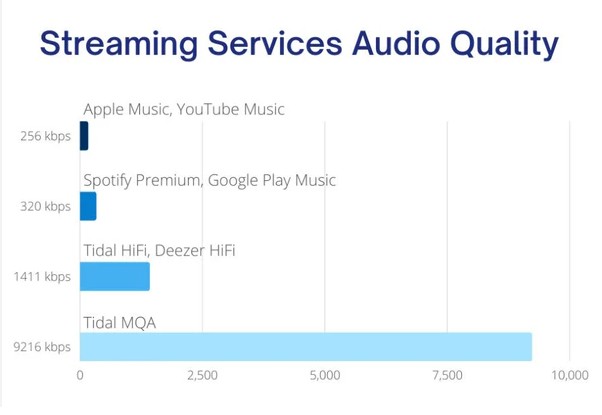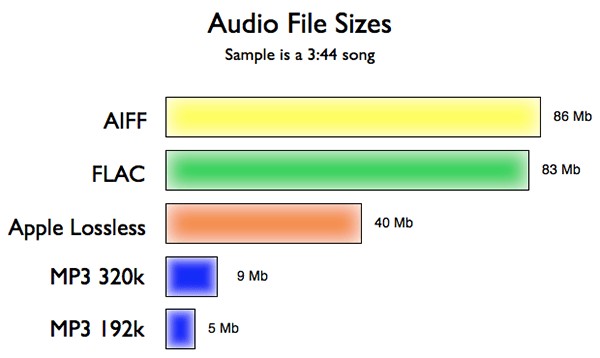Maximizing Your Listening Experience with Lossless Audio
The Benefits of Listening to Lossless Audio

In a world where music is everywhere and easily accessible, the quality of the audio you listen to can greatly impact your overall listening experience. This is where lossless audio comes into play. Unlike compressed audio formats like MP3, lossless audio preserves every bit of the original audio data, resulting in superior sound quality that captures the nuances and subtleties of the music.
One of the main benefits of listening to lossless audio is the enhanced audio fidelity it provides. By retaining all the original details of a recording, lossless audio delivers a richer and more immersive listening experience. From the crisp highs to the deep lows, every note and instrument can be heard with stunning clarity and precision.
Another advantage of lossless audio is the ability to hear the music as the artist intended. With lossless formats like FLAC and ALAC, you can enjoy a more authentic representation of the recording, free from the artifacts and distortions that can occur with compressed files. This means you can truly appreciate the craftsmanship and artistry of the music, just as the artist intended.
Furthermore, listening to lossless audio can also benefit your ears and overall listening skills. By exposing yourself to high-quality audio, you can train your ears to discern subtle nuances in music, leading to a deeper appreciation and understanding of the art form. Additionally, the clarity and realism of lossless audio can help reduce listening fatigue, allowing you to enjoy music for longer periods without strain.
In conclusion, the benefits of listening to lossless audio are clear: superior sound quality, authenticity, improved listening skills, and reduced fatigue. So why settle for anything less? Upgrade your listening experience with lossless audio and discover a whole new world of musical enjoyment.
Choosing the Right Devices for Lossless Audio

When it comes to experiencing the true quality of lossless audio, the devices you use are crucial. To fully immerse yourself in the superior sound, you need to choose the right equipment that can support high-resolution audio formats.
First and foremost, your source device plays a significant role in the quality of your playback. Opt for devices that are specifically designed for high-resolution audio, such as digital audio players and smartphones with advanced audio capabilities. These devices are equipped with better DACs (Digital-to-Analog Converters) and amplifiers, ensuring that the nuances of lossless audio are preserved.
Next, consider investing in a high-quality pair of headphones or speakers. The right set of audio output devices can make a world of difference in how you perceive the audio. Look for headphones or speakers that are capable of reproducing a wide frequency range and have low distortion levels to fully appreciate the details in lossless audio files.
Additionally, if you prefer to listen on-the-go, portable headphone amplifiers can further enhance the audio quality by providing more power to drive your headphones effectively. These portable amplifiers can also improve the signal-to-noise ratio, resulting in cleaner sound reproduction.
By choosing the right devices for lossless audio, you can elevate your listening experience and fully immerse yourself in the rich and detailed sound that high-resolution audio has to offer.
Understanding Lossless Audio Formats
When it comes to enjoying high-quality audio, understanding lossless audio formats is key. Unlike compressed formats like MP3, lossless audio formats retain all the original data, providing listeners with an unparalleled listening experience. One of the most popular lossless audio formats is FLAC (Free Lossless Audio Codec), known for its ability to compress audio without losing any quality. Another common format is ALAC (Apple Lossless Audio Codec), which is ideal for those in the Apple ecosystem.
By choosing the right lossless audio format, you can ensure that your music retains its clarity and richness, allowing you to hear every nuance and detail as the artist intended. When it comes to playback, most modern audio players and devices support lossless audio formats, making it easier than ever to enjoy high-fidelity sound on the go.
Understanding lossless audio formats can also help you make informed decisions when it comes to building your music library. By opting for lossless files, you can future-proof your collection and ensure that your favorite songs sound just as good years from now as they do today.
In conclusion, by familiarizing yourself with lossless audio formats, you can elevate your listening experience to new heights. Whether you’re a casual listener or an audiophile, choosing lossless files is a simple yet effective way to enhance your enjoyment of music.
Setting Up Your Audio Equipment for Maximum Quality

Setting up your audio equipment properly is crucial in order to achieve the best possible sound quality when listening to lossless audio files. Here are some important tips to help you optimize your setup:
- Speaker Placement: Position your speakers correctly in your listening room for optimal sound quality. Make sure they are at ear level and positioned at an equal distance from each other. Avoid placing them too close to walls or corners, as this can cause sound reflections and distortions.
- Amplifier Settings: Adjust the settings on your amplifier to match the specifications of your speakers. Make sure to set the balance, tone controls, and volume levels correctly to avoid any distortions or imbalances in sound quality.
- Cable Quality: Invest in high-quality cables to connect your audio equipment. Using low-quality cables can result in signal loss and a decrease in sound quality. Opt for cables that are made of high-grade materials and have good insulation to minimize interference.
- Room Acoustics: Consider the acoustics of your listening room when setting up your audio equipment. Add acoustic panels or furniture to help absorb sound reflections and improve the overall listening experience.
By following these tips and properly setting up your audio equipment, you can ensure that you are getting the most out of your lossless audio files. A well-optimized setup will enhance the clarity, depth, and overall quality of your listening experience.
Creating the Ideal Listening Environment
When it comes to enjoying lossless audio to its fullest potential, creating the ideal listening environment is key. The setting in which you listen to music can greatly impact the overall experience, enhancing the clarity, depth, and detail of the sound.
To create the ideal listening environment, start by choosing a room that is acoustically optimized. Avoid spaces with hard surfaces that can cause sound reflections and distortion. Instead, opt for rooms with soft furnishings, rugs, and curtains to absorb sound and reduce echoes.
Position your speakers or headphones correctly to ensure that you are receiving the audio in the most accurate way possible. Experiment with different placements to find the optimal spot for your equipment, taking into consideration factors such as symmetry and distance from walls.
Consider investing in soundproofing materials to minimize external noise interference and distractions. This will allow you to fully immerse yourself in the music without any interruptions.
Lastly, pay attention to the lighting in your listening environment. Dim lighting or soft ambient lights can create a more relaxing atmosphere, perfect for music listening sessions. Avoid harsh overhead lighting that can cause eye strain and detract from the overall experience.
By creating the ideal listening environment, you can truly maximize your enjoyment of lossless audio and appreciate the nuances and subtleties of your favorite music in a way you never thought possible.
Where to Find High-Quality Lossless Audio Files

When it comes to experiencing the purest sound quality, nothing beats lossless audio files. These files retain every detail of the original recording, providing listeners with an immersive and true-to-life listening experience. But where can you find high-quality lossless audio files to take your music collection to the next level?
One of the most popular places to source lossless audio files is through online music stores that specialize in high-resolution audio. Platforms like HDtracks, Qobuz, and Tidal offer a wide selection of lossless music in formats like FLAC and ALAC, ensuring that you get the best possible sound quality for your favorite tracks.
For audiophiles who prefer a more traditional approach, physical media formats like CDs and vinyl records are also great sources of lossless audio. Many record labels release special editions of albums in high-fidelity formats, allowing you to enjoy your music collection in its purest form.
Another option for finding high-quality lossless audio files is through music streaming services that offer lossless audio streaming. Platforms like Amazon Music HD and Deezer HiFi provide subscribers with access to an extensive library of lossless tracks, ensuring that you can enjoy your music with maximum clarity and detail.
No matter where you choose to find your high-quality lossless audio files, investing in the best possible sound quality is sure to elevate your listening experience to new heights. So, whether you’re a hardcore audiophile or simply looking to enhance your music collection, make sure to seek out high-quality lossless audio files for the ultimate sonic experience.
Improving Your Listening Skills with Lossless Audio
When it comes to maximizing your listening experience with lossless audio, improving your listening skills is key. As music enthusiasts, we often focus on the technical aspects of audio quality, but our ability to truly appreciate and understand the music is just as important.
One way to enhance your listening skills with lossless audio is to actively engage with the music. Instead of simply letting the music play in the background, take the time to listen closely to the details. Pay attention to the nuances in the instruments, the dynamics of the sound, and the emotions conveyed by the music.
Another tip for improving your listening skills is to experiment with different listening environments. Try listening to your favorite music in a quiet room with high-quality speakers or headphones. Pay attention to how the sound changes in different settings and how it affects your perception of the music.
Additionally, consider expanding your music library with a diverse range of genres and artists. By exposing yourself to a variety of music styles, you can train your ear to appreciate different sounds and structures. This can help you develop a deeper understanding of music and improve your overall listening experience.
Overall, improving your listening skills with lossless audio is about actively engaging with the music, experimenting with different listening environments, and expanding your music horizons. By taking the time to focus on the music and truly listen, you can enhance your enjoyment of high-quality audio and elevate your overall listening experience.
Common Mistakes to Avoid with Lossless Audio

When it comes to enjoying high-quality lossless audio, there are some common mistakes that many people make. By being aware of these pitfalls, you can ensure that you are getting the best listening experience possible.
One of the most common mistakes is not investing in the right audio equipment. While lossless audio files can provide superior sound quality, if your headphones or speakers are not up to par, you won’t be able to fully appreciate the difference. Make sure to choose devices that are specifically designed for lossless audio playback to truly maximize your listening experience.
Another mistake to avoid is not properly setting up your audio equipment. This includes calibrating your speakers or headphones, adjusting the equalizer settings, and ensuring that all connections are secure. By taking the time to fine-tune your setup, you can enhance the clarity and detail of your music.
Additionally, many people overlook the importance of creating the ideal listening environment. Background noise, poor acoustics, and improper seating can all impact the way you perceive sound. To fully immerse yourself in the music, make sure to eliminate distractions and create a space that is conducive to a superior listening experience.
By avoiding these common mistakes and being mindful of how you approach your lossless audio setup, you can truly maximize the potential of your music library. With the right equipment, setup, and environment, you can enjoy crystal-clear audio that will transport you into the heart of the music.
Maximizing Your Music Library with Lossless Audio
When it comes to building your music library, quality is key. With lossless audio, you can take your music collection to the next level by preserving the original audio quality without any compression. This means you get to enjoy every detail and nuance of your favorite songs, just as the artists intended.
To maximize your music library with lossless audio, start by investing in high-quality audio equipment that is capable of playing lossless audio files. Look for devices that support popular lossless formats such as FLAC or ALAC for the best listening experience.
Next, ensure that your audio setup is optimized for maximum quality. This includes setting up your speakers or headphones in the right position, adjusting the equalizer settings, and eliminating any potential sources of interference. By creating the ideal listening environment, you can fully appreciate the richness and depth of your music collection.
When it comes to building your lossless audio library, there are plenty of sources to choose from. Look for reputable online music stores that offer high-quality lossless audio files for purchase or download. You can also explore streaming services that support lossless audio, allowing you to access a vast library of high-fidelity music.
By maximizing your music library with lossless audio, you can elevate your listening experience and rediscover your favorite songs in a whole new way. Embrace the future of audio technology and immerse yourself in the world of lossless sound.
The Future of Lossless Audio Technology

As technology continues to evolve, the future of lossless audio looks brighter than ever. With advancements in audio compression algorithms and storage capabilities, we can expect even higher quality sound with smaller file sizes.
One exciting development is the emergence of new lossless audio formats that promise improved fidelity and efficiency. These formats aim to strike the perfect balance between audio quality and file size, ensuring that listeners can enjoy crystal-clear sound without sacrificing storage space.
Additionally, the integration of artificial intelligence and machine learning in audio processing is set to revolutionize the way we experience music. These technologies can analyze audio data in real-time, adapt to individual listening preferences, and enhance the overall listening experience.
Furthermore, the rise of streaming services dedicated to lossless audio will make high-quality music more accessible to a wider audience. As internet speeds continue to improve, listeners can enjoy their favorite tracks in pristine quality without the need for large downloads or physical media.
Overall, the future of lossless audio technology holds great promise for audiophiles and music lovers alike. With continued innovation and advancements in the field, we can expect a new era of unparalleled sound quality and immersive listening experiences.